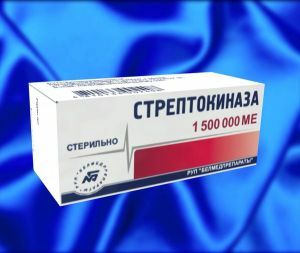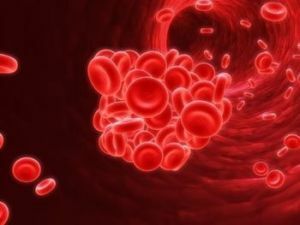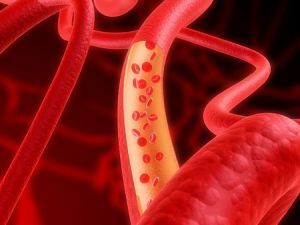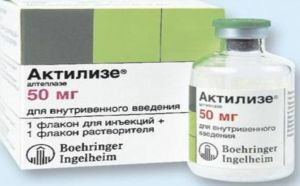 The formation of thrombi is an absolutely safe, natural process in any healthy body. In a case where a person is injured, after a few minutes the bleeding stops.
The formation of thrombi is an absolutely safe, natural process in any healthy body. In a case where a person is injured, after a few minutes the bleeding stops.
This is due to the fact that the clogged small vessels with clots. For the human body, they do not pose any threat.
Even in the case when the thrombus breaks away and is sent to vital organs, the specific substances that are produced by the liver can dissolve it. A healthy person has nothing to worry about.
But how to know that the body is completely healthy? After all, the process of disturbing the balance between the formation of blood clots and their dissolution can lead to disastrous results.
Thrombus can be:
- pristenovye( can partially reduce the lumen of blood vessels);
- occluding( arteries and veins).
- red( erythrocytes, which are glued together with fibrin strands);
- white( leukocytes, platelets, plasma proteins);
- mixed( white and red layers, which alternate).
 Timely prophylaxis of thrombophlebitis will save you and your loved ones from serious health problems.
Timely prophylaxis of thrombophlebitis will save you and your loved ones from serious health problems.
What complications are fraught with post-injection phlebitis and what is needed to avoid this disease. Study the details here.
Effects of thrombolytics on the body
The effect of thrombolytic agents is directed to dissolution of the fibrin clot .
This thrombus can form as in an artery afflicted with atherosclerosis, or it may be the result of embolism.
Thrombosis can be arterial and venous, thromboembolism - pulmonary, systemic and paradoxical.
Localization, as well as the origin of the thrombus and the condition of the patient, are important when deciding whether to perform thrombolytic therapy in a particular case, given the high cost of thrombolytic drugs and the risk of serious complications.
Thrombolytic drugs( fibrinolytic drugs) are used in the acute period of MI, and even with massive or submissive PE, even with thrombosis of large arteries and in the first hours after a stroke of thromboembolic origin.
Venous thrombi are lighter than arterial thromboses, therefore thrombolytics are required in the treatment of PE, in smaller doses than for acute  IM.
IM.
This is not at all surprising, since in the first case the cause of the disease is a venous thrombus, and in the second - a fibrin clot.
Thrombolytic therapy is used to rapidly dissolve a fibrin thrombus and restore anterograde blood flow in the relevant organ or part of it.
To this end, the fibrinolytic activity of the patient's blood needs to be increased, and this can be obtained by such two pathways:
- administration of an in vitro activated plasmin, its content in the blood increases;
- administration of plasminogen activators, increased plasmin formation directly from endogenous plasminogen.
Indications and contraindications for the use of
So, thrombolytic agents are indicated in the following diseases:
- stroke;
- myocardial infarction;
- pulmonary embolism;
- deep vein thrombosis.
Symptoms of these diseases can be :
- chest pain;
- numbness or tingling in some parts of the body;
- speech impediment;
- vision impairment;
- sudden weakness;
- swelling of the lower limbs;
- pain, cold or numbness of the limb.
Thrombolytic therapy with sudden blockage of the vessel should be performed in the first 1-2 hours, then the thrombus is still fresh, it dissolves easily.
But there are also contraindications to the conduct of a similar therapy:
- high blood pressure;
- bleeding or heavy blood loss;
- hemorrhagic stroke;
- severe liver disease;
- ulcerative bleeding.
What is tromobolysis
 Thrombolysis is the process of thrombus dissolution with the help of medications and restoration of blood flow through a blood vessel blocked by a thrombus.
Thrombolysis is the process of thrombus dissolution with the help of medications and restoration of blood flow through a blood vessel blocked by a thrombus.
Immediate cause of stroke, myocardial infarction, pulmonary embolism, deep vein thrombosis is a clotting of blood vessels by a thrombus.
Restoration of blood flow with sudden blockage of the vessel is possible using methods such as thrombolysis, angioplasty with stenting and emergency coronary artery bypass grafting.
But this problem can be solved in the shortest time only by medical thrombolysis, since this procedure is the simplest and also available in performance.
Classification of thrombolytic drugs
Thrombolytic drugs are divided into the following groups:
- Plasma origin agents , which have direct proteolytic as well as specific effects on fibrin. These include activated human plasmin.
- agents, mainly plasminogen activators. Preparations of this group do not act directly on fibrin, but activate fibrinolysis directly or through the proactivator of blood plasminogen, form an active plasmin that acts on fibrin. Preparations of the presented group are divided into activators of human and bacterial origin.
- Combinations of plasmin with activators. Drugs are characterized by different combinations of agents of groups I and II.
The effectiveness of thrombolytics
A comparison of the efficacy of thrombolytics has been conducted in a number of clinical trials. One trial revealed an insignificant advantage of alteplase before streptokinase.
Alteplase was more effective at anterior infarction, and also at the beginning of treatment, during the first 4 hours after the onset of symptoms. It more often contributed to intracranial hemorrhages, but even so, it helped better than streptokinase.
Another test showed that alteplase more often allows recovery of myocardial perfusion and reduces mortality. After these data, anestreplase was used much less often. According to another test, the efficacy of alteplase and reteplase is the same.
The main conclusion of these studies is that an increase in survival rate requires early and persistent recovery of perfusion.
How to use the fibrinolytic agent
Complete lysis of the thrombus will occur more quickly if the drugs are administered directly to the lesion site. 
Intra-aortic administration of streptokinase is contemplated for thrombosis in the aortic bifurcation region and intracoronary administration of fibrinolysin as well as streptokinase in the formation of coronary thrombosis of the coronary arteries of the heart, as well as the introduction of these drugs into the pulmonary artery in the formation of pulmonary artery thrombosis and its branches.
There is evidence that thrombolytics in arterial thrombosis should be administered intraarterially.
Clearly, the conduct of thrombolytic therapy determines the shortest path of circulation between the place of injection and the appearance of thrombi.
If, for example, lysis of the thrombus in the femoral artery is sufficient for the administration of streptokinase within 18-24 h, lysis of the thrombus in the aortic bifurcation region requires continuous administration of the drug for 2-3 days.
The main drugs of the
group The list of the main thrombolytics medications includes 4 preparations: streptokinase, anestreplase, alteplase and reteplase.
Alteplase and streptokinase are administered by continuous intravenous infusion, anestreplase and reteplase - intravenously, to facilitate their use.
The action of all thrombolytics is based on the conversion of the proenzyme plasminogen to the enzyme( plasmin) , which dissolves the thrombus.
Because of the different mechanisms of action, as well as pharmacokinetics, different thrombolytics have different affinity for fibrin. Alteplase, in contrast to streptokinase, exerts an effect primarily on a fresh thrombus, has little effect on systemic fibrinolysis.
But the main side effect of all thrombolytics is bleeding.
